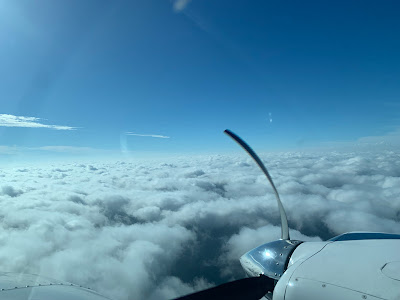Monday I went for a night flight. The weather at home was good, 4000 broken but off to the Northwest, the clouds were lower. I filed an IFR plan to Homerville, GA and back home. Just South of JAX I hit a cloud wall which is what I wanted, I have been building night experience and was expanding to night IFR. I have very little actual IFR at night and this was some good practice weather.
Arriving in the Homerville area I set up for the GPS 32. AWOS was calling for 3500 Overcast and though I turned up the runway lights, I could not see the field. The reason was soon apparent, there was a lower layer between me and the field. At the FAF, I could see the beacon winking at me through the clouds but no runway. Minimums are 491' and the field is at 187' so you an go as low as 300 feet above ground level. Given the conditions I set my minimums at 600 to give me some extra room and started down. I was solid for most of the way but right at 600, poof the clouds parted and the runway was right ahead.
I executed the missed and I guess the AWOS was right as it was clear over the airport. A valuable reminder that the weather over the airport is not always what you may get on the approach.
Tonight I went out again for some more practice. There had been sea fog most of the day at the beach but the forecast was for good weather until after midnight. As I was holding for departure, the chatter on the radio was the approaching fog. Mayport was 400 and Fernandina was 300. I launched but decided to stay close to home. I spent a nice hour watching the fog slowly roll in.
It never quite got to the airport and a few hours later it still hasn't. It did get within about a mile though so not wanting to risk having to divert I headed in at the end of my hour. There was a cool breeze as I pushed the plane into the hangar but it was decidedly warmer at home. Interesting weather and great training.
















